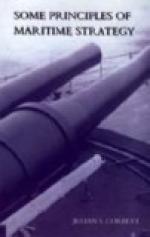It is that limited war permits the use of the defensive without its usual drawbacks to a degree that is impossible in unlimited war. These drawbacks are chiefly that it tends to surrender the initiative to the enemy and that it deprives us of the moral exhilaration of the offensive. But in limited war, as we shall see, this need not be the case, and if without making these sacrifices we are able to act mainly on the defensive our position becomes exceedingly strong.
The proposition really admits of no doubt. For even if we be not in whole-hearted agreement with Clausewitz’s doctrine of the strength of defence, still we may at least accept Moltke’s modification of it. He held that the strongest form of war—that is, the form which economically makes for the highest development of strength in a given force—is strategic offensive combined with tactical defensive. Now these are in effect the conditions which limited war should give—that is, if the theatre and method be rightly chosen. Let it be remembered that the use of this form of war presupposes that we are able by superior readiness or mobility or by being more conveniently situated to establish ourselves in the territorial object before our opponent can gather strength to prevent us. This done, we have the initiative, and the enemy being unable by hypothesis to attack us at home, must conform to our opening by endeavouring to turn us out. We are in a position to meet his attack on ground of our own choice and to avail ourselves of such opportunities of counter-attack as his distant and therefore exhausting offensive movements are likely to offer. Assuming, as in our own case we always must assume, that the territorial object is sea-girt and our enemy is not able to command the sea, such opportunities are certain to present themselves, and even if they are not used will greatly embarrass the main attack—as was abundantly shown in the Russian nervousness during their advance into the Liaotung Peninsula, due to the fear of a counter-stroke from the Gulf of Pe-chi-li.
The actual situation which this method of procedure sets up is that our major strategy is offensive—that is, our main movement is positive, having for its aim the occupation of the territorial object. The minor strategy that follows should be in its general lines defensive, designed, so soon as the enemy sets about dislodging us, to develop the utmost energy of counter-attack which our force and opportunities justify.
Now if we consider that by universal agreement it is no longer possible in the present conditions of land warfare to draw a line between tactics and minor strategy, we have in our favour for all practical purposes the identical position which Moltke regarded as constituting the strongest form of war. That is to say, our major strategy is offensive and our minor strategy is defensive.




